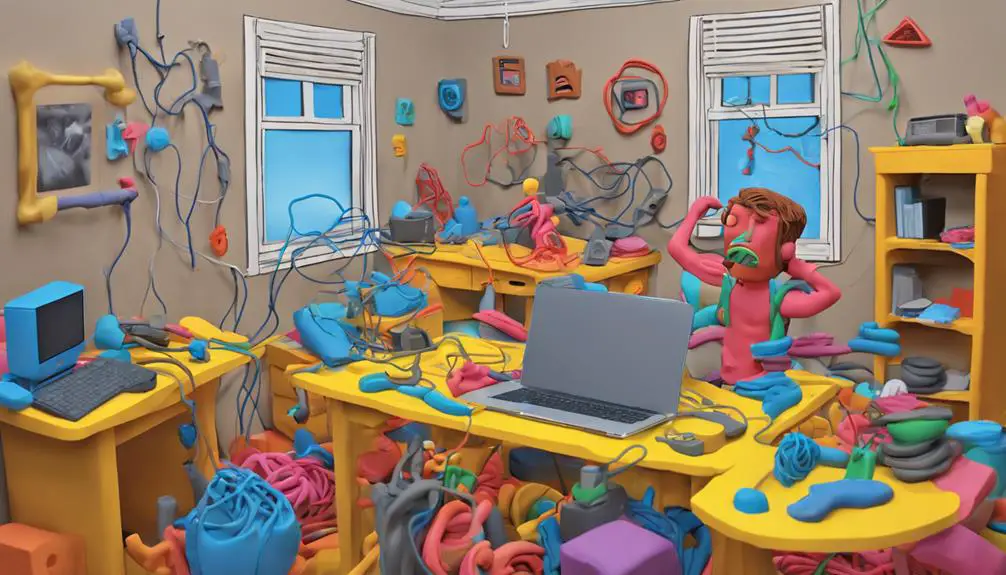When you set up your home Wi-Fi network, you likely didn't think twice about where you placed the router or whether you enabled the right security settings. But these oversights can lead to frustratingly slow speeds, dropped connections, and even security breaches. You're not alone – many people make these mistakes, but the good news is they're easily fixable. By taking a closer look at your router's placement, security measures, and equipment, you can considerably boost your network's performance and reliability. So, what are the most common mistakes you might be making, and how can you start optimizing your network today?
Poor router placement
You're likely guilty of hiding your router in a closet or corner, a common mistake that can considerably reduce your Wi-Fi signal strength and coverage. This hidden router might be out of sight, but it's definitely not out of mind – you'll notice the slow speeds and dropped connections. By tucking your router away, you're creating physical barriers that weaken the signal, making it harder for devices to stay connected.
To fix this, place your router in a central location, away from obstructions and interference sources like microwaves or cordless phones. This will help the signal radiate more evenly throughout your home, giving you stronger and more reliable connections.
Think of it like placing a lamp in the middle of the room – you want the light to shine in all directions, not be blocked by furniture or walls. By moving your router to a more open spot, you'll be amazed at how much better your Wi-Fi performance becomes.
Not securing the network
One of the most critical mistakes you can make is leaving your Wi-Fi network wide open to strangers, a vulnerability that can have serious consequences. When you don't secure your network, you're basically inviting hackers and cybercriminals to take advantage of your online activities. This can lead to identity theft, data breaches, and even malware infections on your devices.
To avoid this, you need to take steps to secure your network. First, enable WPA2 encryption, which is the most secure protocol available. Next, set a strong and unique password for your network. This password should be difficult to guess and not used for any other online accounts.
A good rule of thumb is to use a combination of uppercase and lowercase letters, numbers, and special characters. By taking these simple steps, you'll noticeably reduce the risk of unauthorized access to your network and protect your online privacy.
Don't take your network security lightly – secure it today and enjoy a safer online experience.
Using outdated equipment
Outdated routers can choke your Wi-Fi speeds, leaving your devices in the slow lane. If you're still using an old router, you might be surprised at how much it's holding you back. Old routers may not support the latest Wi-Fi standards and speeds, which means you're not getting the most out of your internet connection.
You mightn't even realize how outdated your router is until you start noticing slow loading times, buffering, and dropped connections. But the fix is simple: upgrade your router every 3-4 years to guarantee compatibility with newer devices and faster speeds. This won't only improve your Wi-Fi performance but also future-proof your network for when new devices and technologies emerge.
Don't wait until your router becomes obsolete; take proactive steps to stay ahead of the game. By upgrading your router regularly, you'll be able to take full advantage of the latest Wi-Fi standards and enjoy a faster, more reliable connection. Your devices (and your sanity) will thank you.
Incorrect channel selection
Upgrading your router is just the first step in optimizing your Wi-Fi network, as another common mistake is selecting the wrong channel, which can lead to interference and slower speeds. You mightn't know it, but using crowded Wi-Fi channels can really slow you down. When you're on the same channel as your neighbors, it's like trying to have a conversation in a noisy room – it's hard to get your signal through.
To avoid this, you need to find a less congested channel. The easiest way to do this is by using a Wi-Fi analyzer app. These apps scan the airwaves and show you which channels are busiest.
With this info, you can manually set your router to use a less crowded channel. It's like moving to a quieter room – your signal will be stronger and faster. By taking control of your channel selection, you'll reduce interference and enjoy faster speeds.
Neglecting network maintenance
Your router's performance can degrade over time if you don't give it a little TLC.
This is because dust, heat, and constant use can slow it down. As a result, you might experience sluggish internet speeds, dropped connections, and poor coverage. To prevent this, you need to maintain your network regularly.
You're probably thinking, 'Maintenance? That sounds like a hassle!' But trust us, it's worth it. Performing simple tasks can breathe new life into your router.
Start by periodically restarting your router. This will clear out any temporary issues and give your network a fresh start.
Next, take a closer look at the devices connected to your network. Are there any you don't recognize? Remove them to prevent unauthorized access.
By doing so, you'll guarantee your network is running smoothly and efficiently.
Not updating firmware
Failing to update your router's firmware is a serious oversight that can leave your network exposed to security risks and performance problems. You mightn't be aware, but outdated firmware can lead to vulnerabilities that hackers can exploit, compromising your online safety. Furthermore, it can also cause issues with your Wi-Fi connection, such as slow speeds, dropped connections, and poor coverage.
You're not alone if you've neglected to update your router's firmware. Many people don't realize the importance of keeping their router's software up to date. However, it's vital to prioritize this task to guarantee your network runs smoothly and securely.
To fix this mistake, make it a habit to regularly check for firmware updates for your router. You can usually find this option in the router's settings or through the manufacturer's website. By staying on top of firmware updates, you'll be able to patch security vulnerabilities, improve performance, and enjoy a more reliable Wi-Fi connection.
Overlooking wired connections
Since you've set up your Wi-Fi network, you might've overlooked a crucial aspect of connectivity: wired Ethernet connections. While Wi-Fi is convenient, it's not always the most reliable option, especially for devices that don't move around.
Wired connections, on the other hand, offer more stability and speed, making them perfect for stationary devices.
Take a closer look at your devices and identify which ones can benefit from a wired connection. Your desktop computer, gaming console, and smart TV are likely candidates. By using Ethernet cables to connect these devices, you'll experience faster data transfer rates and fewer dropped connections. This is especially important for online gaming and streaming, where latency can be a major issue.
To fix this mistake, simply grab some Ethernet cables and connect your devices directly to your router. You might need to purchase longer cables or invest in a network switch, but the improved performance will be worth it.
Ignoring signal boosters
Large homes or those with thick walls often suffer from Wi-Fi dead zones, leaving you struggling to get online in certain areas. If you're experiencing dropped connections or slow speeds in certain rooms, it might be due to the physical limitations of your router's signal. Ignoring signal boosters can be a costly mistake, as it can lead to frustration and decreased productivity.
Consider using Wi-Fi extenders or mesh systems to improve coverage in problem areas. These devices can amplify your router's signal, ensuring a strong and reliable connection throughout your home.
Wi-Fi extenders are relatively affordable and easy to set up, making them a great solution for small to medium-sized homes. For larger homes, mesh systems might be a better option, as they provide a network of interconnected nodes that work together to provide seamless coverage.
Not optimizing router settings
You're likely leaving your Wi-Fi performance on the table by sticking with default router settings that don't cater to your specific needs.
These one-size-fits-all settings mightn't be optimized for your home's unique layout, the number of devices you have, or your internet service provider's (ISP) specifications. As a result, you may experience slow speeds, dropped connections, and poor coverage.
To fix this, you need to dig into your router's settings and make some adjustments. Start by tweaking the transmit power to guarantee your signal reaches every corner of your home.
Next, adjust the channel width to minimize interference from neighboring networks.
Finally, configure Quality of Service (QoS) settings to prioritize traffic for critical applications like video streaming or online gaming.
By optimizing these settings, you'll be able to squeeze the most out of your Wi-Fi network, enjoying faster speeds, better coverage, and a more reliable connection.
Don't settle for subpar performance – take control of your router's settings and release your Wi-Fi's full potential.
Connecting too many devices
Your router can only handle so much, and overwhelming it with too many connected devices can greatly bottleneck your Wi-Fi performance. When you've got a household full of devices, it's easy to forget that each one is competing for bandwidth. Smartphones, laptops, smart TVs, and gaming consoles all add up, slowing down your internet speed and causing frustration.
Having numerous devices on the network can slow down performance for everyone. Imagine trying to have a video call while someone else is streaming their favorite show – it's a recipe for disaster.
To avoid this, you need to take action. Limit the number of connected devices or upgrade to a router that can handle more simultaneous connections. This will guarantee that each device gets the bandwidth it needs, resulting in faster speeds and a smoother online experience.
Final Thoughts
You've learned the common mistakes to avoid when setting up your home Wi-Fi network.
By positioning your router centrally, enabling WPA2 encryption, and upgrading equipment regularly, you'll experience improved speed and coverage.
Don't forget to check for firmware updates, use wired connections, and manage devices to optimize performance.
With these tips, you'll enjoy a reliable and secure network that meets your needs.
Now, go ahead and fine-tune your setup to get the most out of your Wi-Fi connection!




